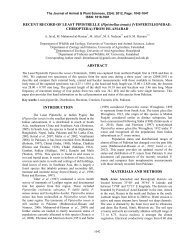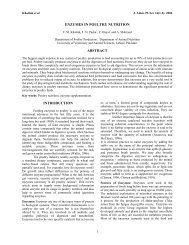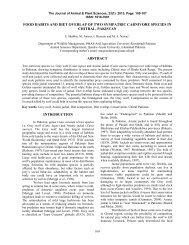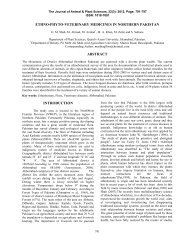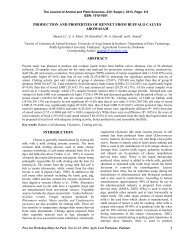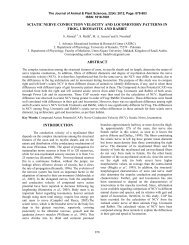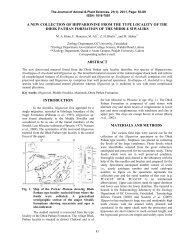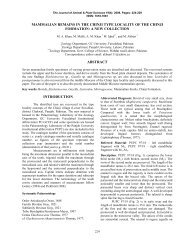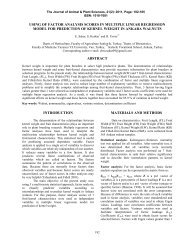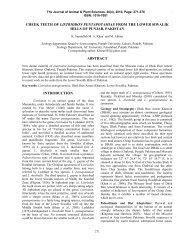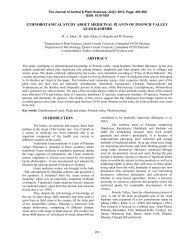taxonomy of some pennate diatoms from kallar kahar lake, district ...
taxonomy of some pennate diatoms from kallar kahar lake, district ...
taxonomy of some pennate diatoms from kallar kahar lake, district ...
Create successful ePaper yourself
Turn your PDF publications into a flip-book with our unique Google optimized e-Paper software.
Munir et al., The Journal <strong>of</strong> Animal & Plant Sciences, 23(2): 2013, Page: J. 457-463 Anim. Plant Sci. 23(2):2013<br />
ISSN: 1018-7081<br />
TAXONOMY OF SOME PENNATE DIATOMS FROM KALLAR KAHAR LAKE,<br />
DISTRICT CHAKWAL, PAKISTAN<br />
M. Munir, R. Qureshi, M. K. Laghari * , M. Arshad and A. Khaliq Ch **<br />
Department <strong>of</strong> Botany, Pir Mehr Ali Arid Agriculture University, Murree Road Rawalpindi, Pakistan.<br />
Corresponding author e-mail: rahmatullahq@yahoo.com<br />
* Pakistan Museum <strong>of</strong> Natural History, Islamabad, Pakistan.<br />
** Department <strong>of</strong> Forestry, Pir Mehr Ali Arid Agriculture University, Murree Road Rawalpindi, Pakistan.<br />
ABSTRACT<br />
Kallar Kahar Lake, an inland brackish water body is situated in District Chakwal, Pakistan. This <strong>lake</strong> is rich in<br />
phytoplankton, but facing shortage <strong>of</strong> water inflow resultantly rapidly drying. Therefore it was worthwhile to record<br />
diatomic flora <strong>of</strong> the <strong>lake</strong> and its tributaries before extinction. During the survey, a total <strong>of</strong> 17 <strong>pennate</strong> <strong>diatoms</strong> belonging<br />
to 10 genera, 7 families and 5 orders were identified. Algal species such as Caloneis tenuis, C. schumanniana, C.<br />
bacillum, C. molaris, C. macedonica, C. undulata, Diadesmis confervaceoides, Diploneis elliptica, Entomoneis<br />
paludosa, Eunotia minor, Gomphonema parvulum var. parvulum, G. truncatum, Haslea spicula, Luticola cohnii,<br />
Mastogloia belaensis and Seminavis strigosa were new record for Pakistan. Based on results it can be concluded that<br />
conservation status <strong>of</strong> the newly reported species should be determined for their management in future.<br />
Key words: Pennate diatom, Kallar Kahar Lake, District Chakwal, Brackish water.<br />
INTRODUCTION<br />
Kalar Kahar Lake is situated in the salt range,<br />
District Chakwal, Pakistan. It is shallow Lake (mean<br />
depth 1.11 m), 135 km away <strong>from</strong> Islamabad, the capital<br />
city on the motorway, joining Lahore to Islamabad. It has<br />
monsoon climate that occurs during July to August. The<br />
rain and fresh water springs contribute to the variation <strong>of</strong><br />
<strong>lake</strong> volume and area (1 - 1.15 Km 2 ). The water <strong>of</strong> the<br />
<strong>lake</strong> is brackish in nature due to continuous flow <strong>of</strong><br />
sulphur salts <strong>from</strong> the hill outskirts, and it is not used for<br />
drinking or agricultural purposes. In the past it was used<br />
as an effluent disposal pond by the settlers <strong>of</strong> Kalar Kahar<br />
town.<br />
Considerable studies on <strong>diatoms</strong> have been<br />
conducted to identify material <strong>from</strong> ponds, puddles,<br />
ditches and streams (Abdul -Majeed, 1935; Sarim and<br />
Khan, 1960; Tariq-Ali et al., 2006a, b, d; Tariq-Ali et al.,<br />
2007; Husnaet al., 2007; Tariq-Ali et al., 2008a, b; Kubra<br />
and Leghari, 2008; Leghari et al., 2009). Only a few<br />
studies are reported dealing with diatom flora <strong>of</strong> Lakes in<br />
Pakistan (Leghari et al., 1986, 1999, 2000, 2005; Munir<br />
et al., 2012).The objective <strong>of</strong> this paper was to record the<br />
diversity <strong>of</strong> <strong>pennate</strong> <strong>diatoms</strong> in the Kallar Kahar Lake<br />
and its tributaries.<br />
MATERIALS AND METHODS<br />
Algal Sampling: Algal samples were collected <strong>from</strong><br />
various sites in the Lake and tributaries. Metaphyton<br />
samples were collected with bucket <strong>from</strong> each <strong>lake</strong> site.<br />
Epilithic algaewere collected with a toothbrush and knife<br />
457<br />
<strong>from</strong> the rocky surfaces on the edge and stones inside<br />
flowing water <strong>of</strong> the tributaries. The algal samples were<br />
preserved in jars containing 2 to 3% formalin.<br />
Microscopic Analysis: Diatoms samples (10 ml) were<br />
acid cleaned and 1 ml cleaned sample was mounted on<br />
slides with Naphrax® (Stevenson et al., 2009). All algal<br />
samples were identified by using a Leica DMLB<br />
microscope® and the <strong>diatoms</strong> were identified at 100x<br />
magnification to the lowest taxonomic level ( Krammer<br />
and Lange-Bertalot, 1997 a, b, c; Lange-Bertalot, 2001;<br />
H<strong>of</strong>man et al., 2011; Siver and Hamilton, 2011).<br />
RESULTS AND DISCUSSION<br />
In all, 17 species belonging to 10 genera 7<br />
families and 5 orders were identified. The <strong>taxonomy</strong> <strong>of</strong><br />
all investigated species is as follows:<br />
Family Diadesmidaceae<br />
Key to genera:<br />
1a. Central area have stigma, raphe straight ….1. Luticola<br />
1b. Central area lack stigma, raphe simple<br />
or T- shaped…………………………... 2. Diadesmis<br />
1. Luticola D.G. Mann in Round et al. (1990).<br />
Symmetrical valves with apices protracted; striae<br />
punctate, central area have stigma; raphe straight; plastid<br />
single, two lobed and central pyrenoids.<br />
Key to species:<br />
1a. Valves with broad poles elliptic to<br />
linear-elliptic…………………………….1. L. cohnii<br />
1b. Valves with acute round poles,
Munir et al., J. Anim. Plant Sci. 23(2):2013<br />
rhombic-elliptic or rhombic-lanceolate…..2. L. mutica<br />
1. Luticola cohnii (Hilse) D. G. Mann (1990), Fig.15<br />
Source <strong>of</strong> Identification: H<strong>of</strong>mann et al. (2011), Table<br />
66, Fig. 31<br />
Basionym: Navicula cohnii (Hilse) Lange-Bertalot 1985<br />
General characters: Length <strong>of</strong> cell 11.9 µm, diameter<br />
4.9 µm; striae 20 /10 µm, punctate, radiate; valves<br />
symmetrical with broad round ends, elliptic to linear<br />
elliptic; central area expanded with stigma axial area<br />
linear-elliptic; single plastid.<br />
Distribution: Antarctica, Australia, Europe and America.<br />
2. Luticola mutica (Kutzing) D.G. Mann (1990), Fig.14<br />
Source <strong>of</strong> Identification: H<strong>of</strong>mann et al. (2011), Table<br />
45, Fig. 36<br />
Basionym: Navicula mutica Kutzing 1844<br />
References: Hussain et al., 1984: 83; Tariq-Ali et al.,<br />
2006a: 438; Husna et al., 2007: 57.<br />
General characters: Length <strong>of</strong> cell 16.9 µm, diameter<br />
6.7 µm; striae 20 /10 µm, punctate, radiate; valves<br />
rhombic-elliptic or rhombic-lanceolate with acute round<br />
ends; axial area linear or lanceolate.<br />
Distribution: Europe, America and Asia: China Iran<br />
andPakistan (Lahore).<br />
2. Diadesmis Kutzing (1844)<br />
Valve linear to linear-lanceolate, small, in<br />
chains; raphe silicified not visible under light microscope,<br />
ends <strong>of</strong> raphe simple or T- shaped; striae parallel;<br />
chromatophore single, lobed.<br />
Diadesmis confervaceoides Lange-Bertalot and U.<br />
Rumrich (2000), Fig.8<br />
Source <strong>of</strong> Identification: Siver and Hamilton ( 2011),<br />
Table 184, Fig. 14<br />
Synonym: Diadesmis confervacea Kutzing 1844; D.<br />
peregrina W. Smith 1857; Navicula confervacea var.<br />
hungarica Grunow in Van Heurck1880; N. confervacea<br />
var. peregrine Grunow in Van Heurck1880<br />
General characters: Length <strong>of</strong> cell 14.1 µm, diameter<br />
5.3 µm; striae 24 /10 µm.<br />
Distribution: Europe, America and Asia ( China and<br />
Iran).<br />
Family: Diploneidaceae<br />
3. Diploneis Ehrenberg (1844)<br />
Valve shape elliptic to panduriform; striae<br />
punctate, have alveola; plastids two, pyrenoids single in<br />
each; raphe straight, with visible, thick longitudinal<br />
canals on either side.<br />
458<br />
Diploneis elliptica (Kutzing) Cleve (1891), Fig.9<br />
Source <strong>of</strong> Identification: Krammer and Lange-Bertalot<br />
(1997), Table 108, P. 659, Fig.4<br />
Basionym: Navicula elliptica Kutzing 1844<br />
General characters: Cells length18.2 µm, diameter 10<br />
µm; striae 15/10 µm.<br />
Distribution: America, Europe, Australia andAsia<br />
(China).<br />
Family: Entomoneidaceae<br />
4. Entomoneis Ehrenberg (1845)<br />
Cell solitary frustule twisted along the apical axis,<br />
panduriform; keeled raphe in each valve; plastids two and<br />
large.<br />
Entomoneis paludosa (W. Smith) Reimer (1975),<br />
Fig.11<br />
Source <strong>of</strong> Identification: Krammer and Lange-Bertalot<br />
(1997), Table 204. P. 855, Fig. 3<br />
Synonym: Amphiprora paludosa W. Smith 1853<br />
General characters: Cells length56.8 µm, diameter 12<br />
µm; striae 23/10 µm.<br />
Distribution: Australia, North America and Europe.<br />
Family: Eunotiaceae<br />
5. Eunotia Ehranberg(1837)<br />
Cells solitary or in cluster, sessile; valves curved<br />
or arcuate; raphe excentric in concave side; rectangular<br />
girdle view; plastids two, laminate.<br />
Eunotia minor (Kutzing) Grunow in Van Heurck<br />
(1881), Fig.10<br />
Source <strong>of</strong> Identification: Krammer and Lange-<br />
Bertalot(1997), Table 142 P. 515, Fig.6<br />
Basionym: Himantidium minus Kutzing 1844<br />
Synonym: Himantidium minus Kutzing 1844; Eunotia<br />
pectinalis var. minor (Kutzing) Rabenhorst 1864; E.<br />
pectinalis var. minor (Kutzing) Grunow in Van Heurck<br />
1881; E. impressa var. angusta (Kutzing) Grunow in Van<br />
Heurck 1881; E. pectinalis var. minor f. impressa<br />
(Ehrenberg) Hustedt 1930<br />
General characters: Cells length44.4 µm, diameter 8.6<br />
µm; striae 10/10 µm.<br />
Distribution: Europe<br />
Family: Gomphonemataceae<br />
6. Gomphonema Ehrenberg nom. cons. (1832)<br />
Cells solitary, sessile and free floating,<br />
asymmetric in valve view, wedge shape in girdle view;
Munir et al., J. Anim. Plant Sci. 23(2):2013<br />
valves cuneate, clavate, lanceolate, with one end broader<br />
then the other; narrow axial area; straight raphe; striae<br />
transverse or slightly radiate; central area, <strong>some</strong>times<br />
extending to the margins, with asymmetrically placed<br />
dot; single chromatophore, pyrenoid single.<br />
Key to species:<br />
1a. Striae 11 in10 µm …………………….1. G. parvulum<br />
1b. Striae 12 in10 µm …………………...2. G. truncatum<br />
1. Gomphonema parvulum (Kutzing) Kutzing (1849),<br />
Fig.17<br />
Source <strong>of</strong> Identification: Siver and Hamilton ( 2011),<br />
Table 99, Fig. 2<br />
Basionym: Sphenella parvula Kutzing<br />
Synonym: Sphenella parvula Kutzing 1844;<br />
Gomphonema lagenula Kutzing 1844; Gomphonema<br />
micropus Kutzing 1844<br />
References: Zaman and Hussain, 2006: 81;<br />
LeghariandGhafar, 2006: 169.<br />
General characters: Length <strong>of</strong> cell 27.2 µm, diameter<br />
7.2 µm; striae 11 /10 µm; valve clavate-lanceolate, with<br />
slightly constricted end.<br />
Distribution: Europe, Asia: Iran, Singapore and China<br />
and Pakistan: Peshawar, Islamabad (Rawal Dam ) and<br />
Japan.<br />
2. G. truncatum Ehrenberg (1832), Fig.13<br />
Source <strong>of</strong> Identification: Krammer and Lange-Bertalot,<br />
(1997), Table 159, P. 761 .Fig.14.<br />
Synonym: Gomphonema constrictum Ehrenberg 1832;<br />
G. capitataum Ehrenberg 1838; G. aturgidum Ehrenberg<br />
1854<br />
General characters: Length <strong>of</strong> cell 24.2 µm, diameter<br />
10 µm; striae 12 /10 µm, transverse, radiate; valve very<br />
broad at one end and gradually taper <strong>from</strong> the middle to<br />
the end <strong>of</strong> the other pole or cone shape; one pole broadly<br />
round, other narrow round; central area irregular.<br />
Distribution: Europe, Australia and New Zealand and<br />
Asia (Iran and China).<br />
Family: Mastogloiaceae<br />
7. Mastogloia Thwaitesin W. Smith (1856)<br />
Valves lanceolate, elliptic or rhomboid, with<br />
broad round ends, acute or rostrate; internal septa<br />
present, each with a central oval chamber and several<br />
linear perforations; axial area narrow; raphe straight,<br />
striae transverse; chromatophores two.<br />
Mastogloia belaensis Voigt (1956), Fig.12<br />
459<br />
Source <strong>of</strong> Identification: Lange-Bertalot ( 2000), Plate<br />
74, Fig. 1<br />
General characters: Length <strong>of</strong> cell 48.5 µm, diameter<br />
15.4 µm; striae 15 /10 µm, punctate; valve broadly<br />
elliptic to lanceolate; central area broad.<br />
Distribution: Florida<br />
Family: Naviculaceae<br />
Key to genera:<br />
1a. Valve asymmetric……………….……..1. Seminavis<br />
1b. Valve symmetric:<br />
2a. Valve spindle shaped……………………. 2. Haslea<br />
2b. Valve elliptical linear or lanceolate….. 3. Caloneis<br />
8. Caloneis Cleve (1894)<br />
Cells solitary, free floating, linear or linearlanceolate,<br />
with round, protracted capitate ends; striae<br />
parallel, radiate crossed by hyaline area; chromatophores<br />
two, pyrenoids two in each.<br />
Key to species:<br />
1a. Length <strong>of</strong> cells 20.2 µm ………………..…1 C. tenuis<br />
1b. Length <strong>of</strong> cells more than 20.2 µm:<br />
2a. Central area narrow………….... 2. C. schumanniana<br />
2b. Central area broad:<br />
3a. Striae 26 /10 µm ………………………3. C. bacillum<br />
3b. Striae 19 /10 µm …………………….…4. C. molaris<br />
4a.Valve with protracted, capitate ends..5. C. macedonica<br />
4b. Valve with round ends……………….. 6. C. undulate<br />
1. Calonei stenuis (Gregory) Krammer(1985), Fig.3<br />
Source <strong>of</strong> Identification: Krammer and Lange-Bertalot<br />
(1997), Table 174, P. 793, Fig.8<br />
Synonym: Pinnularia tenuis Gregory Krammer 1954; P.<br />
gracillima Gregory Krammer 1956.<br />
General characters: Length <strong>of</strong> cells 20.2 µm, diameter<br />
4.3 µm; striae 23 /10 µm, parallel, radiate in the middle,<br />
at the ends slightly convergent; valves linear to linear<br />
elliptic; Axial area variable, central area asymmetric.<br />
Distribution: Reported <strong>from</strong> Europe.<br />
2. Caloneis schumanniana (Grunow) Cleve (1894),<br />
Fig.6<br />
Source <strong>of</strong> Identification: Krammerand Lange-Bertalot<br />
(1997), Table 171, P. 793, Fig. 2<br />
Synonym: Navicula schumanniana Grunow 1880; N.<br />
trochus Schumann 186 non N. trochus Ehrenberg 1838;<br />
Caloneis trochus (Schumann) A. May 1941; C. limosa<br />
sensu Patrick in Patrick and Reimer 1966.
Munir et al., J. Anim. Plant Sci. 23(2):2013<br />
Plates:<br />
Fig.1.Caloneismolaris Fig.2.Caloneisbacillum Fig.3.Caloneistenuis<br />
Fig.4.Caloneismacedonica Fig.5.Caloneisundulata<br />
460<br />
Fig.6.Caloneisschumanniana<br />
Fig.7.Seminavisstrigosa Fig.8.Diadesmisconfervaceoides Fig.9.Diploneiselliptica
Munir et al., J. Anim. Plant Sci. 23(2):2013<br />
Fig.10.Eunotia minor Fig.11.Entomoneispaludosa Fig.12.Mastogloiabelaensis<br />
Fig.13.Gomphonematruncatum Fig.14.Luticolamutica Fig.15.Luticolacohnii<br />
Fig.16.Gomphonemaparvulumva<br />
r. Parvulum<br />
General characters: Length <strong>of</strong> cells 49.2 µm, diameter<br />
8.2 µm; striae 20 /10 µm, radiate in the middle, at the end<br />
parallel and radiate; valves linear, linear-elliptic to<br />
lanceolate; axial area lanceolate.<br />
Distribution: Reported <strong>from</strong> Europe, Australia and Asia<br />
(China).<br />
3. Caloneisbacillum (Grunow) Cleve (1894), Fig.2<br />
Fig.17.Gomphonemaparvulum<br />
461<br />
Fig.18.Hasleaspicula<br />
Source <strong>of</strong> Identification: Krammerand Lange-Bertalot<br />
(1997), Table 173, P. 791, Fig. 4<br />
Basionym: Stauroneis bacillum Grunow<br />
Synonyms: Stauroneis bacillum Grunow 1860; Navicula<br />
fasciata Lagerstedt 1873; Caloneis fasciata ( Lagerstedt)<br />
Cleve1894; Caloneis bacillaris (Gregory) Cleve 1894<br />
References: Hirano, 1971: 90.
Munir et al., J. Anim. Plant Sci. 23(2):2013<br />
General characters: Length <strong>of</strong> cells 26.4 µm, diameter<br />
6.1 µm; striae 26 /10 µm, parallel; Valve area linear or<br />
lanceolate, broad, round ends; band like central area;<br />
raphe straight.<br />
Distribution: Himalaya, Europe, America and Asia<br />
(Japan).<br />
4. Caloneis molaris (Grunow) Krammer (1985), Fig.1<br />
Source <strong>of</strong> Identification: Krammerand Lange-Bertalot<br />
(1997), Table 174, P.793, Fig.21<br />
Synonym: Navicula molaris Grunow Krammer 1863;<br />
Pinnularia molaris (Grunow) Cleve 1995; Caloneis<br />
clevei sensuHustedt 1930<br />
General characters: Length <strong>of</strong> cells 36.1 µm, diameter<br />
7.5 µm; striae 19 /10 µm parallel radiate throughout, at<br />
the ends parallel convergent; valves linear lanceolate;<br />
broad central area, axial area variable, linear to broad<br />
lanceolate.<br />
Distribution: Europe and South-West- Asia (Israel).<br />
5. Caloneis macedonica Hustedt (1945), Fig.4<br />
Source <strong>of</strong> Identification: Krammer and Lange-Bertalot<br />
(1997), Table 175, P .795, Fig.7<br />
General characters: Length <strong>of</strong> cells 36.9 µm, diameter<br />
7.9 µm; striae 22 /10 µm, radiate in middle, convergent at<br />
the ends; valves linear-lanceolate, with protracted<br />
capitate poles; axial area linear, lanceolate, central area<br />
broad.<br />
Distribution: Europe<br />
6. Caloneis undulata (Gregory) Krammer (1985), Fig.5<br />
Source <strong>of</strong> Identification: Krammer and Lange-Bertalot<br />
(1997), Table 176, P. 794, Fig.6<br />
Synonym: Pinnularia undulata Gregory 1854<br />
General characters: Length <strong>of</strong> cells 31 µm, diameter 6.6<br />
µm; striae 22 /10 µm, parallel and radiate in the middle,<br />
convergent at the ends; valve lanceolate, with round ends;<br />
axial area linear, central area broad; raphe filiform.<br />
Distribution: Europe.<br />
9. Haslea R. Simonsen(1974)<br />
Cells solitary and fusiform; valve linear-lanceolate;<br />
striaetrasverse and longitudinal; chloroplast two, plate<br />
like.<br />
Hasleaspicula (Hickie) Lange-Bertalot(1997), Fig.18<br />
Source <strong>of</strong> Identification: Krammerand Lange-Bertalot<br />
(1997),P. 545, Fig. 5<br />
Synonym: Stauroneis spicula Hickie 1874; Navicula<br />
spicula (Hickie) Cleve 1894<br />
462<br />
General characters: Length <strong>of</strong> cells 63.8 µm, diameter<br />
8.8µm; striae /10 µm, radiate, parallel; valves lanceolate<br />
or spindle shape, with round ends; axial area linear.<br />
Distribution: Europe, Australia, America and New<br />
Zealand.<br />
10. Seminavis D.G. Mann (2003)<br />
Cells lanceolate to rhombic lanceolate with rounded ends;<br />
uniseriatestriae; plastidstwo.<br />
Seminavis strigosa (Hustedt) Danielidiset Economou-<br />
Amilliin Danielidis Mann 2003, Fig.7<br />
Basionym: Amphora strigosaHustedt1949<br />
General characters: Cells lanceolate to rhombic<br />
lanceolate with rounded ends; length 26.6µm, diameter<br />
6.0µm; striae 17/ 10 µm.<br />
Distribution: USA: California, Asia: Israel and Thailand.<br />
Acknowledgement: The first two authors thankfully<br />
acknowledge the Higher Education Commission,<br />
Islamabad Pakistan for undertaking this piece <strong>of</strong> work<br />
under HEC Indigenous 5000 Fellowship Program Batch-<br />
VI and International Research Support Initiative Program<br />
(IRSIP). Thanks are due to Dr. R. Jan Stevenson,<br />
Michigan State University, USA for providing laboratory<br />
facilities for algal species identification.<br />
REFERENCES<br />
Abdul-Majeed (1935). Freshwater algae <strong>of</strong> Punjab I.<br />
Bacillariophyta (Diatom eae). Punj. Univ., Publ.<br />
Lahore (Pakistan). 45 p<br />
Hirano, M. (1971). Freshwater algae <strong>of</strong> the North-<br />
Western Himalayas: Reprint: Contributions <strong>from</strong><br />
the Biological Laboratory Kyoto University.<br />
23(2) 81-116.<br />
H<strong>of</strong>mann, G., M. Werum and H. Lange- Bertalot, Edit:<br />
H. Lange- Bertalot (2011). Diatomeenim<br />
Subwasser-Benthos von Mittleuropa. Publisher<br />
Gantner Verlag K. G. 908 p<br />
Husna, R., A. Zarina, Masud-ul-Hasan and M. Shameel<br />
(2007). Taxonomic study <strong>of</strong> <strong>some</strong> <strong>diatoms</strong> <strong>from</strong><br />
Lahore, Pakistan. Int. J. Phycol. Phycochem.<br />
3(1):55-64.<br />
Hussain, F., G. Anjum, M. I. Zaidi and M. A. F. Faridi<br />
(1984). Fresh water algae <strong>of</strong> Hanna Urak Valley<br />
Quetta. Pakistan J. Bot.16(1):81-84.<br />
Krammer, K. and H. Lange-Bertalot(1997a).<br />
Subwasserflora von Mitteleuropa,<br />
Bacillariophyceae: Bacillariaceae,<br />
Epithemiaceae, surirellaceae. Gustav Fisher<br />
Verlag Jena; Berlin.611 p<br />
Krammer, K. and H. Lange-Bertalot (1997b).<br />
Subwasserflora von Mitteleuropa,
Munir et al., J. Anim. Plant Sci. 23(2):2013<br />
Bacillariophyceae: Naviculaceae. Gustav Fisher<br />
Verlag Jena; Berlin.876 p<br />
Krammer, K. and H. Lange-Bertalot (1997c).<br />
Subwasserflora von Mitteleuropa,<br />
Bacillariophyceae: Centrales, Fragilariaceae and<br />
Eunotiaceae. Gustav Fisher Verlag Jena;<br />
Berlin.576 p<br />
Kubra, G. and M. K. Leghari (2008). Ecological study <strong>of</strong><br />
algal species <strong>of</strong> rumly streams, Islamabad. Int.J.<br />
Phycol. Phcochem.4(1):19-30.<br />
Lange- Bertalot, H. (2000). IconographiaDiatomologica:<br />
Annotated Diatom Monograph. A. R. G.<br />
Gantner Verlag K. G; Germany.925 p<br />
Lange-Bertalot, H. (2001). Naviculasensustricto. 10<br />
genera separated <strong>from</strong> NaviculalatoFrustulia.<br />
Diatoms <strong>of</strong> Europe: <strong>diatoms</strong> <strong>of</strong> European inland<br />
waters and comparable habitats.Edit Lange-<br />
Bertalot, H., A. R. G. Gantner Verlag K. G;<br />
Germany. 526 p<br />
Leghari, S. M., S. N. Arbani and M. Y. Khuharwar<br />
(1986). A preliminary survey <strong>of</strong> the algal flora<br />
<strong>of</strong> Dhilyar Salt Lake, Dist. Sanghar, Sindh,<br />
Pakistan. Sindh Univ. Res. J. (Sci. Ser.). 18 (1):<br />
179-184.<br />
Leghari, S.M., M. Y. Leghari, M.Y. Khuhawar, T.M.<br />
Jahangir and M. Leghari ( 2005). Limnological<br />
studies <strong>of</strong> Hanna Lake and Urak spring <strong>of</strong><br />
Quetta, Balochistan, Pakistan. Int .J. Phycol.<br />
Phcochem. 2(1):33-38.<br />
Leghari, M. K. and M. Y. Leghari ( 1999). Seasonal<br />
variation <strong>of</strong> phytoplankton part- I in fresh water<br />
Lake Bakar District Sanghar, Sindh. Pakistan J.<br />
Sci. Peshawar Uni. 5 (2): 159- 171.<br />
Leghari, M. K., S. I. H. Jafri and M. Y. Khauahawar<br />
(2000). Limnological study <strong>of</strong> Sonharo, Mehro,<br />
Pateji and Chotiari Lakes <strong>of</strong> District Badin,<br />
Sindh, Pakistan. Pakistan J. Bio. Sci.3 (1):1904-<br />
1909.<br />
Leghari, M. K. and S.A. Ghaffar (2006). Epilithic algal<br />
species <strong>of</strong> Rawal Dam water, Islamabad. Int. J.<br />
Phycol. Phcochem. 2(2):165-172.<br />
Leghari, M. K., M.I. Jalalani, M.H. Soomoro and S.N.<br />
Arbani ( 2009). Composition dynamics <strong>of</strong><br />
epiphytic algal flora on Hydrilla verticellata<br />
(Hydrocharitaceae) in Rawal Dam water <strong>of</strong><br />
Islamabad. Int. J. Phycol. Phcochem. 5(2):155-<br />
166.<br />
463<br />
Munir, M., R. Qureshi, M. Arshad, A.K. Chaudhry and<br />
M.K. Laghari (2012). Taxonomic study <strong>of</strong><br />
Bacillariophyta <strong>from</strong> Kallar Kahar Lake<br />
Chakwal, Punjab, Pakistan. Pakistan J. Bot.<br />
44(4): 1805-1814.<br />
Sarim, K. M. and M. H. Khan ( 1960). Diatomales:The<br />
fresh water <strong>diatoms</strong> <strong>of</strong> Peshawar valley. Deptt.<br />
<strong>of</strong> Botany, Peshawar Univ. Peshawar.66 p<br />
Siver, P. A. and Hamilton, P. B. Edit: H. Lange-Bertalot<br />
(2011). Iconographia Diatomologica: Diatom <strong>of</strong><br />
North America. A. R.G. Gantner Verlag K.G.;<br />
Germany. 923 p<br />
Stevenson, R. J., L. Novoveska, C. M. Riseng and M. J.<br />
Wiley ( 2009). Comparing responses <strong>of</strong> diatom<br />
species composition to natural and<br />
anthropogenic factors in streams <strong>of</strong> glaciated<br />
ecoregions. Nova Hedwigia,135: 1-13.<br />
Tariq-Ali, S., A. Zarina, Masud-ul-Hasan and M.<br />
Shameel (2006a). Taxonomic studies on<br />
Cymbella (Bacillariophyta) <strong>from</strong> Punjab and<br />
Azad Kashmir. Pakistan J. Bot. 38: 161-167.<br />
Tariq-Ali, S., A. Zarina, Masud-ul-Hasan and M.<br />
Shameel ( 2006b). Taxonomic studies on<br />
Navicula (Bacillariophyta) <strong>from</strong> certain areas <strong>of</strong><br />
the Punjab, Pakistan. Pakistan J. Bot. 38: 435-<br />
441.<br />
Tariq-Ali, S., A. Zarina, Masud-ul-Hasan and M.<br />
Shameel (2006d). Diversity <strong>of</strong> Pinnularia<br />
(Bacillariophyta) in the north-eastern areas <strong>of</strong><br />
Pakistan. Pakistan J. Bot.38: 1249-1255.<br />
Tariq-Ali, S., A. Zarina, Masud-ul-Hasan and M.<br />
Shameel ( 2007). Occurrence <strong>of</strong> the family<br />
Pinnulariaceae (Bacillariophyta) in various<br />
<strong>district</strong>s <strong>of</strong> the Punjab, Pakistan. Pakistan J. Bot.<br />
39:1797-1805.<br />
Tariq-Ali, S., Masud-ul-Hasan and M. Shameel (2008a).<br />
Occurrence <strong>of</strong> Pennate <strong>diatoms</strong> (Bacillariopyta)<br />
in the Punjab and N. W. F. P, Pakistan. Pakistan<br />
J. Bot. 40(2): 841-847.<br />
Tariq-Ali, S., Masud-ul-Hasan and M. Shameel (2008b).<br />
Taxonomic study on certain <strong>diatoms</strong> <strong>from</strong><br />
freshwater habitats <strong>of</strong> North-Eastern areas <strong>of</strong><br />
Pakistan. Proc. Pakistan Acad. Sci. 45(3): 117-<br />
123.<br />
Zaman, A. and F. Hussain (2006). Impact <strong>of</strong> water<br />
quality on the algal diversity during winter<br />
season in Peshawar valley, Pakistan. Int. J.<br />
Phycol. Phcochem. 2(1): 77-86.



